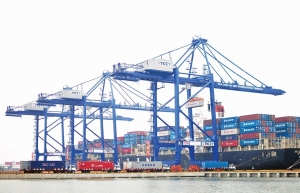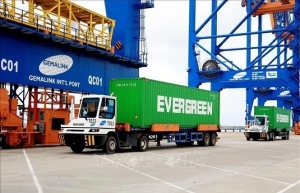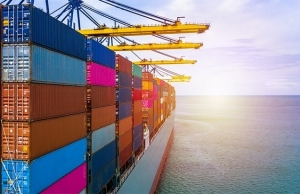Ports poised for more growth amid ferocious competition
Geopolitical tensions, trade restrictions, international sanctions, piracy incidents, missile strikes, cyberattacks, sanitary restrictions, and soaring insurance premiums are presenting the international shipping industry with unprecedented challenges.
 |
| Patrick Lenain, senior associate at the Council on Economic Policies |
Despite these headwinds, the movement of goods across the world’s oceans remains steady. According to the UN Conference on Trade and Development, which monitors global shipments of bulk freight and containers, international shipping rebounded in 2023 with an estimated growth of 2.4 per cent, and it is projected to grow at a pace of 2-3 per cent per year in the near term.
Managing the rapid growth in shipments requires an efficient logistics chain capable of seamlessly moving bulk freight and containers across oceans, ensuring timely delivery. This efficiency is crucial for the global manufacturing industry, which relies on just-in-time delivery, as demonstrated by the significant bottlenecks experienced in global shipping hubs during the pandemic.
Highly efficient deep-sea ports are the backbone of international shipping. In Asia, the port of Singapore consistently ranks among the best, featuring prominently on Lloyd’s list of 100 ports and the World Bank – S&P Global Container Port Index.
Not all ports are equally effective in handling cargo. The most competitive ports can load and unload a container in under one minute, while it can take several minutes at others. Automation across cranes and yards plays a significant role in cargo handling performance, but not all ports are equipped with such technology.
Delays at ports can also result from administrative and institutional bottlenecks during the clearing of goods. Customs clearance is essential to ensure compliance with tax, sanitary, environmental, and financial regulations. These procedures can be expedited by trade facilitation measures such as single administrative window systems, electronic data exchange systems, pre-clearance of goods, and advanced screening technologies.
Singapore has maintained its competitive edge through investments in advanced infrastructure, automated technologies, efficient customs and regulations, and state-of-the-art management practices. In 2023, the port handled 39 million containers, the second-highest volume globally after Shanghai, marking significant growth from the previous year.
Red Sea attacks and congestion
Singapore’s port mainly functions as a transhipment hub, where cargoes are unloaded and reloaded onto different ships for their final destinations. Transhipment accounts for 80 per cent of the port’s activity. Rather than proximity to a consumer market, this requires proximity to international shipping lines, ample storage space, and highly efficient container handling. Singapore is a preferred destination for liners managing large volumes of shipment boxes.
However, Singapore’s attractiveness has also led to challenges. As container ships reroute to avoid attacks in the Red Sea, they bypass Middle Eastern ports and instead dock at Singapore, leading to increased congestion. This has resulted in vessels waiting at anchorage for up to seven days before unloading, incurring significant costs for shipping companies.
To mitigate these delays, Singapore port authorities have taken measures, including reopening closed berths, to reduce waiting times to a more acceptable two days. Additionally, international shippers have started diverting their container ships to other regional ports, such as those in Malaysia and Vietnam, which have the capacity to handle more traffic.
International shipping companies now have a growing array of options for unloading cargo in Southeast Asia, thanks to substantial investments in infrastructure development along deep-sea routes.
Malaysia offers attractive port facilities at Tanjung Pelepas near Singapore and Klang near Kuala Lumpur. Thailand provides port services at Laem Chabang, while Vietnam offers ports in Ho Chi Minh City and Haiphong.
Cargo traffic is increasing at Vietnam’s deep-sea ports, although these ports remain mid-sized players in international shipping. In 2023, Cat Lai port in Ho Chi Minh City handled 7.9 million containers, while Haiphong processed 5.6 million. Although these marine terminals have some capacity to handle additional cargo, a lack of infrastructure could quickly become a constraint.
Vietnam is currently benefiting from congestion in Singapore, but this advantage may be short-lived unless long-term improvements in trade logistics are made.
Aligning Vietnam’s trade facilitation processes with international best practices will be key. According to the Trade Facilitation Indicator 2022, Vietnam was ranked 62nd, well behind leaders like South Korea, Hong Kong, China, and Singapore.
A 2021 report by the US Agency for International Development encouraged Vietnam to accelerate its reforms and prepare for the anticipated growth in cargo shipments at Cat Lai terminal. Key areas for reform include customs, data processing, judicial processes, border cooperation, governance, and digitalisation.
Significant progress has been made since then, exemplified by the ratification of the World Trade Organization’s Trade Facilitation Agreement. The government has introduced an integrated information system and a single window compatible with ASEAN’s systems. Additionally, the various free trade agreements ratified by Vietnam include commitments to trade facilitation.
However, much work remains. Border clearance procedures by line ministries are time-consuming. Managing trade procedures is particularly challenging for small- and medium-sized enterprises, which would benefit from greater stakeholder engagement with government agencies.
While the costs and fees associated with port services in Vietnam are low, this alone will not suffice to compete with major hubs where international shippers expect automated handling, electronic customs clearance, cross-border cooperation, stakeholder engagement, and impartial governance. As other shipping hubs continue to enhance their infrastructure and procedures, Vietnam must demonstrate its commitment to remaining a key player in international deep-sea logistics and supply chains.
 |
| Ports poised for more growth amid ferocious competition, Photo Le Toan |
Sustainable shipping
In response to government actions and public pressure, industries across the board are intensifying efforts to reduce their carbon footprints. Deep-sea transportation and logistics must also rise to the challenge.
Traditionally exempt from environmental regulations, the shipping industry could account for 10 per cent of global emissions by 2050 if no action is taken. While international waters are beyond the jurisdiction of national legislations, international shippers are facing growing demand for clean transportation. Multinational companies are increasingly reporting their Scope 3 emissions, which include downstream and upstream emissions, and they are keen to ensure that their products are transported by environmentally friendly ships.
International maritime hubs must prepare for this shift. Ports that excel in reducing their carbon emissions and offering low-carbon services to ships while at berth will attract more business. A critical first step is to drastically reduce the carbon footprint of port operations.
Port authorities should mandate the use of electric-powered equipment and vehicles within ports. Electrifying cranes, forklifts, and other machinery could significantly reduce emissions, as would upgrading to more energy-efficient lighting and equipment.
Another key step is enabling ships to connect to the electric grid while docked, reducing reliance on fossil-fuel power generators. Ensuring that ships do not spend several days waiting at anchorage and burning fuel before unloading is also necessary. Additionally, preventing trucks from idling for hours before entering port facilities is crucial. Good planning and the use of AI can help achieve these goals.
The shipping industry has yet to determine its definitive path to decarbonisation. Various experiments with liquefied natural gas, methanol, biofuels, hydrogen, hybrid engines, lithium batteries, and ammonia are underway, but the future direction remains unclear. Port authorities must closely monitor these developments and be prepared to adapt when a clear trend emerges.
As part of Vietnam’s commitment to achieving net-zero carbon emissions by 2050, maritime ports should develop pathways to become low-carbon hubs. A good starting point would be ensuring that the electricity used within port premises is generated from renewable sources such as solar, wind, or hydroelectric power. An immediate opportunity is to directly contract electricity from a 100 per cent renewable energy supplier, now possible thanks to a decree on the direct power purchase agreements issued by the government of Vietnam in July.
Located in the fast-growing Southeast Asia, well integrated into global supply chains, and in close proximity to deep-sea shipping lines, Vietnam’s maritime ports have the potential to expand beyond their current mid-size status. A shift towards low-carbon port activities, automated infrastructure, and best-practice trade facilitation will be critical.
Competition is fierce, with other hubs also moving quickly, but Vietnam has shown that it can succeed when it is determined to achieve its national objectives.
 | Seaport investment creates new promise The seaport industry’s evolution in Vietnam continues to be driven by the government’s development strategy towards 2030 and beyond. |
 | Vietnamese seaports to handle 1.2-1.4 billion tonnes of cargo by 2030 Vietnam's seaport cargo throughput is set to reach 1.2-1.4 billion tonnes by 2030, with container cargo expected to range from 46.3 to 54.34 million TEUs, according to a detailed plan for the development of seaport groups, wharfs, jetties, buoy berths, and water areas in 2021-2030, with a vision to 2050. |
 | Some adaption efforts paying off at seaports After various setbacks, joint venture seaports in Vietnam came out of the shadows in the first half of 2024, but many still worry about prolonged challenges. |
 | Ba Ria-Vung Tau to become a global logistics hub The southern province of Ba Ria-Vung Tau has implemented solutions to modernise its seaports and logistics infrastructure, as well as improve its investment climate by streamlining its administrative procedures in the hope of attracting further investment. |
What the stars mean:
★ Poor ★ ★ Promising ★★★ Good ★★★★ Very good ★★★★★ Exceptional
Related Contents
Latest News
More News
- 14th National Party Congress affirms Party’s leadership role, Vietnam’s right to self-determined development (January 20, 2026 | 09:27)
- Direction ahead for low-carbon development finance in Vietnam (January 14, 2026 | 09:58)
- Vietnam opens arms wide to talent with high-tech nous (December 23, 2025 | 09:00)
- Why global standards matter in digital world (December 18, 2025 | 15:42)
- Opportunities reshaped by disciplined capital aspects (December 08, 2025 | 10:05)
- Fresh M&A cycle ahead as reforms begin to take effect (December 08, 2025 | 08:00)
- What foreign investors need to know to unlock new deals (December 08, 2025 | 08:00)
- Telecoms advances expected to penetrate all sectors and fields (December 03, 2025 | 13:00)
- Main drivers for Vietnam’s digital economy future (December 03, 2025 | 11:35)
- Pivotal stage of growth paves way for rise in M&As (December 03, 2025 | 10:00)

 Tag:
Tag:



















 Mobile Version
Mobile Version